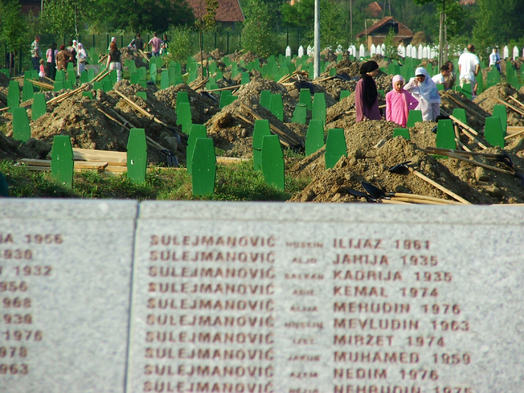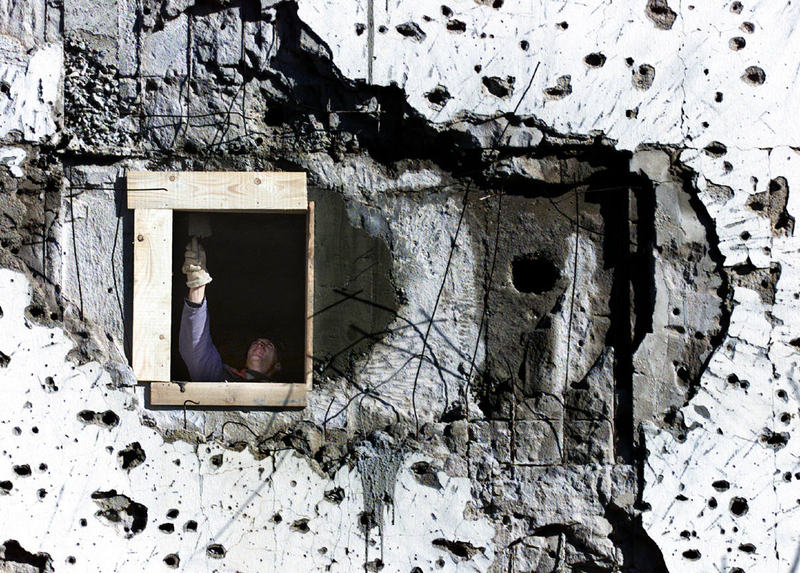
During the Yugoslav Wars which began in 1992, armed conflicts broke out between country's ethnic Serbs, Croats and Bosniaks (Bosnian Muslims). The harshest and most murderous of those clashes took place in Bosnia. Tens of thousands of Bosniaks were tortured and subjected to bloodthirsty massacres in over ten concentration camps. Dozens of Bosnian cities and towns were destroyed and plundered. Despite being designated as safe areas by the UN, Bosnian cities of Sarajevo, Gorazde, Tuzla, Zepa, Srebrenica, Bihac witnessed continuous mass murders. One of those massacres took place in Srebrenica. Bosnian Serbs murdered over 10,000 Bosniak Muslims in Srebrenica in a course of 10 days starting from the 6th of July 1995. Documents proved that Ratko Mladic commanded operations for killing hundreds of women and children in Bosnia. 400 Dutch soldiers recruited to protect peace were blamed for failing to prevent the massacring of innocent people in Srebrenica, a safe area designated by the UN, the soldiers of the peacekeeping mission did nothing but watch. Srebrenica Massacre was recorded as the biggest mass murder in Europe since the WW II. The massacre is also known as the first documented mass murder in Europe.
Prior to the war, Muslim Bosniaks, Orthodox Serbs and Catholic Croats were living together in Bosnia. On the 25th of June in 1991, Croatian and Slovenian parliaments declared their independence which later on would lead to war in the region. Soon after that, the common army of the state, called Yugoslav People’s Army (INA) has turned into being the army of Serbs and first attacked Slovenia and then Croatia on the 27th of June. Serbs began to carry out murderous raids in the region and killed innocent civilians. On the 21st of February in 1992 the UN Security Council declared Resolution 743, which established a peacekeeping mission in the country, known as the United Nations Protection Force (UNPROFOR) aiming to serve in the conflict regions of former Socialist Federal Republic of Yugoslavia. On the 3rd of March in 1992, Bosnia Herzegovina declared its independence and the European Union Council of Ministers recognized the independent state. However, this could not prevent the war and the Bosnian war began despite the efforts by the deceased President of Bosnia, Aliya Izetbegovic. Previously, Bosniaks and Bosnian Croats were fighting against the Serbs in cooperation, then violent clashes began between the two groups as well. Conflicts in the region became severer as the UN implemented its policy of “disarmament of the civilian population and establishing safe areas”. Later on, the UN Security Council, declared Resolution 824 which designated Sarajevo, Tuzla, Zepa, Gorazde and Bihac as safe areas in addition to Srebrenica. EU’s plan for land distribution between Bosnians, Serbs and Croats caused extreme bitterness in Croats and Serbs which led to a bigger conflict in the region.

Srebrenica Massacre
While Serbs were heavily bombing Bosnian territories, Sarajevo was under siege as well. It remained under siege almost through the entire war. Srebrenica, as a safe area, had a totally different meaning for the people in Bosnia. As a designated safe area, it was a refuge for innocent people who escaped the war. The population had reached almost 45,000 in Srebrenica region. However, there were only 400 UN soldiers to protect the civilians. Dutch forces who were serving as a part of the UN peacekeeping mission, had taken an unbelievable step and decided to leave thousands of civilians, women and children, unprotected before Serbs. Serbian forces under the command of Ratko Mladic transferred innocent civilians by buses and trucks and mass murdered them in forests and in factories.
12,000 people embarked on a long journey to escape from death. Besides, males over 10 years old who remained in Srebrenica were being killed in groups and women were subjected to mass rape. Men, women and the elderly tried to escape towards Tuzla through forests. Only 3000 of those were able to run away from the mass killings. Serbian soldiers were waiting for them and killing them on their way to Tuzla, on the journey which they named as the “walk to salvation”. Those who were able to reach Tuzla after five days of walking were safe. The ones that were captured on the way were executed in Podrinje. The number of people killed and massacred in Srebrenica and on the way to Tuzla within 10 days is over 10,000.
15 years have passed since the massacre, however, mass graves are still being discovered. Bodies found in those mass graves can only be identified through DNA tests. Large ceremonies of commemoration are held in Bosnia Herzegovina, every year on the 11th of July. This year, 775 bodies were identified through DNA tests and buried. Thousands of bodies belonging to Bosnian men have been found so far in 13 mass graves around Srebrenica. Bodies of more than 2000 Bosnians who were massacred in Srebrenica still could not be found. One of the most striking things about the Srebrenica massacre is the fact that Ratko Mladic, one of the main players in the massacre, still has not been caught. It is well known that Mladic has been living in Serbia for years.